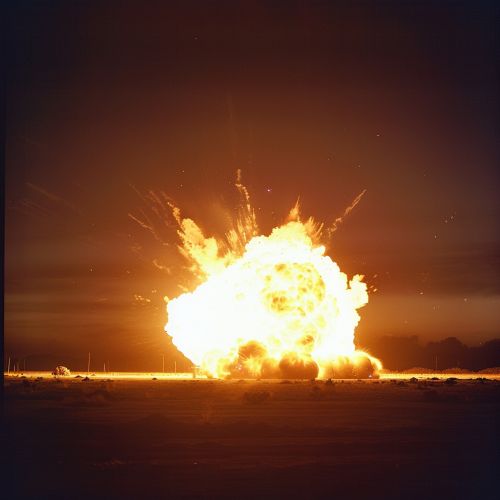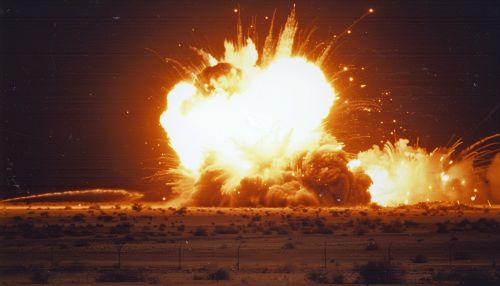Explosion
Introduction
An explosion is a rapid increase in volume and release of energy in an extreme manner, usually with the generation of high temperatures and the release of gases. An explosion creates a shock wave. If the shock wave is a supersonic detonation, then the source of the blast is called a "high explosive".[1]
Physics of Explosions
Explosions occur when energy is released into a low-pressure area in a very short time. The energy can be released from a chemical reaction, nuclear reaction, or the sudden release of stored potential energy. This energy is then transferred to the surrounding medium, creating a shock wave and rapidly expanding gas.[2]


Chemical Explosions
Chemical explosions are a class of explosion where the rapid release of energy comes from a chemical reaction. This class can be further divided into two types: physical and nuclear explosions. Physical explosions are a large and sudden release of energy due to a physical or chemical process.[3]
Physical Explosions
Physical explosions are caused by the rapid release of pressure, gas, or heat. Examples include steam explosions, volcanic eruptions, and the bursting of a pressurized container. The energy for a physical explosion is stored in the form of potential energy.[4]
Nuclear Explosions
Nuclear explosions are caused by the rapid release of energy from a high-speed nuclear reaction. The reaction can be either fission or fusion. Fission explosions can be produced by a critical mass of plutonium or uranium. Fusion explosions require a much higher temperature and pressure and are initiated by a fission explosion.[5]
Effects of Explosions
The effects of an explosion depend on several factors, including the type of explosive, the distance from the explosion, and the surrounding environment. The main effects are blast and fragmentation. Blast refers to the shock wave and air blast produced by the explosion, while fragmentation refers to the shrapnel produced by the explosion.[6]
Safety and Precautions
Safety measures are necessary to prevent accidental explosions. These include proper storage and handling of explosives, adequate training for those working with explosives, and appropriate emergency response plans. In addition, regulations and standards have been established to promote safety in the use of explosives.[7]
See Also
- ↑ Zukas, Jonas A. (1990). Introduction to Hydrocodes. Elsevier. p. 1. ISBN 978-0-08-053679-3.
- ↑ Zukas, Jonas A. (1990). Introduction to Hydrocodes. Elsevier. p. 1. ISBN 978-0-08-053679-3.
- ↑ Zukas, Jonas A. (1990). Introduction to Hydrocodes. Elsevier. p. 1. ISBN 978-0-08-053679-3.
- ↑ Zukas, Jonas A. (1990). Introduction to Hydrocodes. Elsevier. p. 1. ISBN 978-0-08-053679-3.
- ↑ Zukas, Jonas A. (1990). Introduction to Hydrocodes. Elsevier. p. 1. ISBN 978-0-08-053679-3.
- ↑ Zukas, Jonas A. (1990). Introduction to Hydrocodes. Elsevier. p. 1. ISBN 978-0-08-053679-3.
- ↑ Zukas, Jonas A. (1990). Introduction to Hydrocodes. Elsevier. p. 1. ISBN 978-0-08-053679-3.
